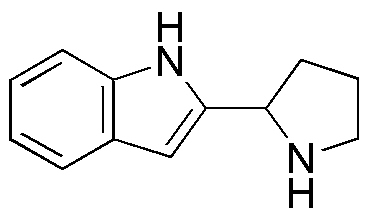2-Pyrrolidin-2-yl-1H-indole is widely utilized in research focused on:
- Pharmaceutical Development: This compound serves as a key intermediate in the synthesis of various pharmaceuticals, particularly in the development of drugs targeting neurological disorders.
- Neuroscience Research: It is used in studies investigating receptor interactions and signaling pathways in the brain, aiding in the understanding of cognitive functions and potential treatments for mental health conditions.
- Organic Synthesis: The compound is a valuable building block in organic chemistry, facilitating the creation of complex molecules with specific properties, which can be applied in various chemical industries.
- Material Science: It finds applications in the development of advanced materials, such as polymers and coatings, enhancing their performance through improved chemical stability and durability.
- Biological Studies: Researchers utilize this compound to explore its effects on cellular processes, contributing to the development of new therapeutic strategies in cancer and other diseases.
General Information
Properties
Safety and Regulations
Applications
2-Pyrrolidin-2-yl-1H-indole is widely utilized in research focused on:
- Pharmaceutical Development: This compound serves as a key intermediate in the synthesis of various pharmaceuticals, particularly in the development of drugs targeting neurological disorders.
- Neuroscience Research: It is used in studies investigating receptor interactions and signaling pathways in the brain, aiding in the understanding of cognitive functions and potential treatments for mental health conditions.
- Organic Synthesis: The compound is a valuable building block in organic chemistry, facilitating the creation of complex molecules with specific properties, which can be applied in various chemical industries.
- Material Science: It finds applications in the development of advanced materials, such as polymers and coatings, enhancing their performance through improved chemical stability and durability.
- Biological Studies: Researchers utilize this compound to explore its effects on cellular processes, contributing to the development of new therapeutic strategies in cancer and other diseases.
Documents
Safety Data Sheets (SDS)
The SDS provides comprehensive safety information on handling, storage, and disposal of the product.
Product Specification (PS)
The PS provides a comprehensive breakdown of the product’s properties, including chemical composition, physical state, purity, and storage requirements. It also details acceptable quality ranges and the product's intended applications.
Certificates of Analysis (COA)
Search for Certificates of Analysis (COA) by entering the products Lot Number. Lot and Batch Numbers can be found on a product’s label following the words ‘Lot’ or ‘Batch’.
*Catalog Number
*Lot Number
Certificates Of Origin (COO)
This COO confirms the country where the product was manufactured, and also details the materials and components used in it and whether it is derived from natural, synthetic, or other specific sources. This certificate may be required for customs, trade, and regulatory compliance.
*Catalog Number
*Lot Number
Safety Data Sheets (SDS)
The SDS provides comprehensive safety information on handling, storage, and disposal of the product.
DownloadProduct Specification (PS)
The PS provides a comprehensive breakdown of the product’s properties, including chemical composition, physical state, purity, and storage requirements. It also details acceptable quality ranges and the product's intended applications.
DownloadCertificates of Analysis (COA)
Search for Certificates of Analysis (COA) by entering the products Lot Number. Lot and Batch Numbers can be found on a product’s label following the words ‘Lot’ or ‘Batch’.
*Catalog Number
*Lot Number
Certificates Of Origin (COO)
This COO confirms the country where the product was manufactured, and also details the materials and components used in it and whether it is derived from natural, synthetic, or other specific sources. This certificate may be required for customs, trade, and regulatory compliance.


